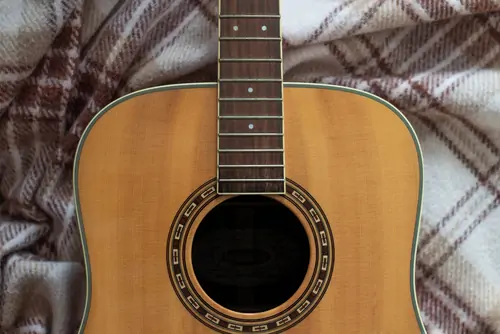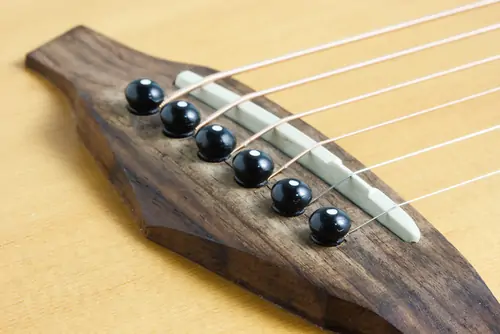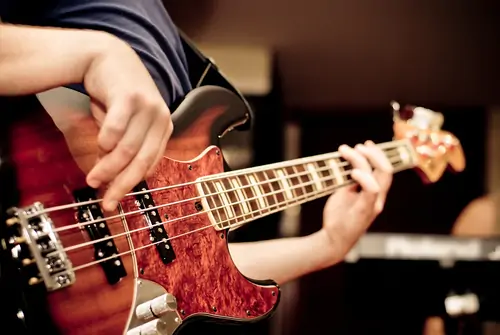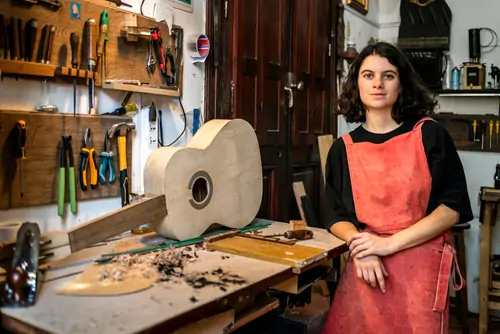Classical guitars are known for their rich, warm tones that seem to improve with age. But what is it about the aging process that makes these instruments sound better over time?
There are a variety of factors that contribute to the unique sound of a classical guitar, from the materials used to the shape of the instrument itself.
One of the key factors in the sound of a classical guitar is the type of wood used in its construction. Most classical guitars are made from spruce and rosewood, which are known for their resonant qualities and ability to produce clear, bright tones.
As the guitar ages, the wood becomes more porous and flexible, allowing it to vibrate more freely and produce a fuller, more complex sound.
Another important factor is the design of the guitar itself. Classical guitars are typically smaller and more lightweight than their steel-string counterparts, with a wider neck and lower string tension.
This unique design allows for greater control and precision when playing, as well as a more intimate, nuanced sound.
Key Takeaways on Why do Classical Guitars Sound Better with Age?
- Classical guitars sound better with age due to the aging of the wood and the unique design of the instrument.
- Materials such as spruce and rosewood contribute to the rich, warm tones of a classical guitar.
- The smaller, lightweight design of the guitar allows for greater control and precision in playing, as well as a more intimate, nuanced sound.
Check out these other top picks:
- Find the Best Classical Guitar Under 500
- What Are the Disadvantages of Classical Guitar?
- Is it Better to Start with Classical or Acoustic Guitar?
Understanding Classical Guitars

Classical guitars are known for their unique sound and timeless appeal. They are typically made of wood and have a hollow body that produces rich, warm tones. The construction of a classical guitar involves several key components, including the body, neck, and headstock.
The body of a classical guitar is typically made of wood, which can vary depending on the model and manufacturer.
The most common types of wood used for classical guitar bodies include spruce, cedar, and mahogany. These woods are chosen for their tonal qualities, as well as their durability and resistance to warping.
The neck of a classical guitar is also made of wood, typically mahogany or rosewood. The neck is attached to the body of the guitar and is responsible for holding the strings in place.
The headstock, located at the top of the neck, contains the tuning pegs, which are used to adjust the tension of the strings.
One of the most important figures in the history of classical guitar construction is Antonio de Torres. He is known for developing the modern classical guitar design, which includes a larger body size and a fan bracing pattern that enhances the guitar’s tonal qualities.
As classical guitars age, they often develop a richer, more complex tone. This is due to a combination of factors, including the aging of the wood and the way the guitar is played and cared for over time.
Many musicians believe that a well-made classical guitar will only improve with age, making it a valuable investment for serious players.
Materials Used in Classical Guitars
Classical guitars are known for their warm and rich sound, which is a result of the materials used in their construction.
The quality of the materials used in a guitar’s construction can have a significant impact on the sound it produces. In this section, we discuss the materials commonly used in classical guitar construction.
Wood Types

The type of wood used in a guitar’s construction is one of the most important factors that determine its sound quality. The two most important types of wood used in guitar construction are spruce and rosewood.
Spruce is commonly used for the top of a guitar because of its excellent tonal qualities. It is a lightweight wood that produces a bright and resonant sound. Rosewood, on the other hand, is used for the back and sides of the guitar. It is a dense wood that produces a warm and rich sound.
Other types of wood that are commonly used in guitar construction include maple and mahogany. Maple is a hard and dense wood that is often used for the neck and body of the guitar. It produces a bright and clear sound.
Mahogany, on the other hand, is a soft and lightweight wood that is often used for the neck and sides of the guitar. It produces a warm and mellow sound.
Glue and Other Materials
In addition to the wood used in guitar construction, the glue and other materials used can also have an impact on the sound quality. The quality of the glue used can affect the resonance of the guitar. High-quality glue allows the wood to vibrate freely, which results in a better sound.
Other materials used in guitar construction include the fretboard, bridge, and nut. These materials can also affect the sound quality of the guitar. High-quality materials, such as solid wood and quality tonewoods, can produce a better sound.
How Age Affects Sound

Aging Process
Classical guitars are known to produce a better sound as they age. The aging process involves several changes in the wood that affect the sound quality. As the wood matures, it becomes denser, stiffer, and more responsive to vibrations, resulting in a richer and more resonant tone.
The aging process of the wood is a slow and gradual process that takes several years, and it is influenced by several factors such as humidity, temperature, and the quality of the wood.
Impact of Humidity and Moisture
Humidity and moisture are essential factors that affect the aging process of the wood. The wood of the guitar is hygroscopic, which means it can absorb and release moisture depending on the humidity levels in the environment.
When the humidity levels are high, the wood absorbs moisture, which causes it to swell. When the humidity levels are low, the wood releases moisture, which causes it to shrink.
This constant expansion and contraction of the wood due to changes in humidity levels can cause stress on the wood, leading to cracks and other structural damage.
Physical Properties Changes
The aging process of the wood also causes several physical changes that affect the sound quality of the guitar. As the wood becomes denser and stiffer, it can transmit sound waves more efficiently, resulting in a louder and more resonant tone.
The aging process also causes changes in the cell structure of the wood, which affects the responsiveness of the wood to vibrations. The wood becomes more responsive to vibrations, resulting in a more dynamic and expressive tone.
The Role of Guitar Components

When it comes to the sound of a classical guitar, the components that make up the instrument play a crucial role in determining the quality of sound produced. In particular, the soundboard, nut and fretboard, bridge and saddle all contribute to the unique sound of a classical guitar.
1. Soundboard
The soundboard is the top part of the guitar body that amplifies the sound produced by the strings. It is typically made of spruce or cedar and is responsible for producing the majority of the guitar’s tonal characteristics.
As the guitar ages, the soundboard can become more resonant and responsive, resulting in a richer and more complex sound.
2. Nut and Fretboard
The nut and fretboard are responsible for determining the pitch of the notes played on the guitar. The nut is located at the top of the fretboard and the strings pass over it before being anchored to the tuning pegs.
The fretboard is the flat surface that runs along the neck of the guitar and contains the frets that determine the pitch of the notes.
As the guitar ages, the nut and fretboard can become more polished and smooth, resulting in a more comfortable playing experience. Additionally, the frets can become more worn, which can affect the intonation of the guitar.
3. Bridge and Saddle
The bridge and saddle are located on the lower part of the guitar body and are responsible for transmitting the vibrations of the strings to the soundboard.
The bridge is the wooden piece that anchors the strings to the body of the guitar, while the saddle is the small piece of bone or plastic that sits on top of the bridge and helps to transmit the vibrations to the soundboard.
As the guitar ages, the bridge and saddle can become more worn, resulting in a change in the angle of the strings and the tension on the soundboard. This can affect the overall tone and volume of the guitar.
Strings and Their Impact

When it comes to the sound of a classical guitar, strings play a critical role. Over time, the materials and construction of strings have evolved, and the choice of strings has a significant impact on the sound of the guitar.
Nylon Strings
Nylon strings have long been the preferred choice for classical guitars. They produce a warm, mellow tone that is well-suited to the genre. Nylon strings are made of a combination of nylon and other synthetic materials, and they are available in a variety of gauges and tensions.
One of the main advantages of nylon strings is that they are gentle on the fingers. They are also less prone to breakage than metal strings, which can be a concern for players who perform frequently.
Nylon strings tend to produce a more muted sound than metal strings, which can be desirable for certain styles of playing.
Metal Strings
While nylon strings are the traditional choice for classical guitars, some players prefer the brighter, crisper sound of metal strings. Metal strings are typically made of steel or bronze, and they are available in a range of gauges and tensions.
One advantage of metal strings is that they produce a louder sound than nylon strings, which can be beneficial for players who perform in larger venues.
Metal strings also tend to have a longer lifespan than nylon strings, which can be a consideration for players who want to avoid the hassle of frequent string changes.
However, metal strings can be harder on the fingers than nylon strings, and they can be more prone to breakage. They also tend to produce a more harsh, metallic sound that may not be as well-suited to classical guitar playing.
Influence of Guitar Shape and Size

The shape and size of a classical guitar can significantly affect its sound quality and tone. The shape and size of the guitar determine the amount of air that can be moved by the soundboard, which is responsible for producing the guitar’s sound.
The larger the guitar’s body, the more volume it can produce. However, larger guitars can be more challenging to play for people with smaller hands. Conversely, smaller guitars are easier to play but may not produce as much volume as larger guitars.
The shape of the guitar also affects its sound quality. Classical guitars typically have a shape that is wider at the bottom and narrower at the top. This shape allows for a larger soundboard, which produces a more resonant sound.
In addition to the shape and size of the guitar, the materials used to make the guitar can also affect its sound quality. For example, guitars made from high-quality woods such as cedar or spruce can produce a warmer, more resonant sound.
Notable Brands and Models
While many classical guitars improve with age, certain brands and models are known for their exceptional sound quality and craftsmanship.
One such brand is Yamaha, which has been producing classical guitars for over 50 years. Yamaha’s classical guitars are renowned for their high-quality construction, excellent playability, and beautiful tone. The Yamaha GC series, in particular, is highly regarded by both beginners and professionals alike.
Vintage classical guitars are also highly sought after for their unique sound and character. Brands such as Ramirez, Fleta, and Hauser are known for producing some of the finest classical guitars ever made. These guitars are often highly collectible and can command high prices at auction.
In addition to these notable brands, certain models have also gained a reputation for their exceptional sound quality.
The Ramirez 1A, for example, is widely considered to be one of the finest classical guitars ever made. Its rich, warm tone and excellent projection make it a favorite among professional guitarists.
Electric vs. Acoustic Guitars

When it comes to sound quality, there is a clear difference between electric and acoustic guitars. Electric guitars rely on amplification to produce their sound, while acoustic guitars produce sound naturally through the vibration of their strings.
Electric guitars are often preferred by musicians who play rock, metal, or other genres that require a more aggressive or distorted sound. They offer a wide range of tonal options through the use of effects pedals and other equipment.
Acoustic guitars, on the other hand, are favored by musicians who play folk, country, or other styles that rely on a more natural, organic sound. They offer a warm, rich tone that is often associated with classical music.
When it comes to aging, acoustic guitars tend to improve in sound quality over time, while electric guitars do not.
This is because acoustic guitars are made of natural materials, such as wood, that can change and mature over time. The wood can become more resonant, resulting in a richer, more complex sound.
Electric guitars, on the other hand, are made of synthetic materials, such as plastics and metals, that do not change over time. While some musicians may prefer the sound of an older electric guitar due to its unique character, it is not a result of the guitar aging in the same way as an acoustic guitar.
The Appeal of Vintage and Aged Guitars
There’s something special about a vintage guitar. It’s not just the old-school look and feel; it’s the unique sound that comes with age. As guitars age, their tone changes, becoming richer and more complex.
This is especially true for classical guitars, which are made from wood and are particularly susceptible to changes in humidity and temperature.
Many guitarists prefer the sound of vintage acoustic guitars to newer models. They believe that the wood used to make older guitars was of a higher quality and that the construction methods were superior.
Additionally, vintage guitars often have a unique character that can’t be replicated by modern instruments.
Of course, not everyone prefers vintage guitars. Some musicians prefer the sound of newer instruments, which can be brighter and more focused. It all comes down to personal preference.
However, there’s no denying that vintage guitars have a certain charm and appeal that can’t be found in newer models.
In recent years, the popularity of vintage guitars has skyrocketed. Collectors and musicians alike are willing to pay top dollar for rare and well-preserved instruments. This has led to an increase in the value of vintage guitars, making them even more desirable to collectors.
The Role of the Luthier

The luthier plays a crucial role in the sound quality of a classical guitar. A skilled luthier can select the best materials and construct the guitar in a way that maximizes its tonal potential.
This is especially important in the early stages of a guitar’s life, as the initial construction can have a lasting impact on the instrument’s sound.
One important technique that luthiers use is called A.R.E. (Acoustic Resonance Enhancement). This process involves treating the wood with heat, humidity, and pressure in order to simulate the aging process and bring out the full potential of the wood’s natural tonal qualities.
A.R.E. can help to accelerate the aging process of a guitar and bring out the rich, warm tones that are associated with older instruments.
However, it’s important to note that not all luthiers use A.R.E. or other similar techniques. Some prefer to rely on traditional methods and allow the guitar to age naturally over time. Ultimately, the choice of construction methods and materials is up to the individual luthier and their personal preference.
Another important factor in the role of the luthier is their level of experience and skill. A skilled luthier with years of experience can create a guitar that not only sounds great when it’s new, but will also continue to improve with age.
This is because they have a deep understanding of the materials and construction methods that will produce the best possible sound quality.
Potential Drawbacks of Aging
While there are many benefits to owning a classical guitar that has aged well, there are also some potential drawbacks to keep in mind.
One of the main issues that can arise with an older guitar is cracking. This is especially true for guitars that have been exposed to extremes in temperature or humidity.
As the wood dries out and becomes more brittle over time, it is more susceptible to cracking. While some cracking can add character to the guitar, too much can significantly impact the sound quality and playability.
Another potential drawback of aging is stiffness. As the wood ages, it can become stiffer and less responsive. This can make it more difficult to play, especially for beginners or those with less developed finger strength.
While some stiffness can be compensated for with adjustments to the guitar’s setup, too much can make the guitar less enjoyable to play.
It’s also important to note that not all guitars age well. Some may develop structural issues or other problems that impact their sound quality or playability. It’s important to have any older guitar evaluated by a professional before making a purchase to ensure that it is in good condition.
Frequently Asked Questions

What factors contribute to the improved sound of classical guitars over time?
Classical guitars improve in sound over time due to several factors. One of the primary factors is the aging of the wood, which causes the guitar to resonate more fully and produce a richer, fuller sound.
Additionally, the strings and other components of the guitar may also contribute to the improved sound over time.
What changes occur in the wood of classical guitars as they age?
As classical guitars age, the wood may become more resonant due to changes in the density and stiffness of the wood fibers. This can result in a fuller, richer sound that is highly sought after by many musicians.
Additionally, the wood may develop a unique patina or coloration over time, which can add to the guitar’s aesthetic appeal.
Can the sound of a classical guitar be improved with proper care and maintenance?
Yes, proper care and maintenance can help to improve the sound of a classical guitar. Regular cleaning, tuning, and restringing can help to ensure that the guitar is producing the best possible sound.
Additionally, storing the guitar in a controlled environment can help to prevent damage to the wood and other components over time.
Are there any downsides to owning an older classical guitar?
While owning an older classical guitar can be highly desirable for many musicians, there are some potential downsides to consider.
Older guitars may require more maintenance and repair than newer models, and the cost of repairs can be significant.
Additionally, older guitars may have a less consistent sound quality than newer models, which can make them more difficult to play in certain situations.
Is it worth investing in an older, high-quality classical guitar?
For many musicians, investing in an older, high-quality classical guitar can be a smart decision.
These guitars often have a unique sound and character that cannot be replicated by newer models, and they can also appreciate in value over time.
However, it is important to carefully consider the cost and potential maintenance requirements before making a purchase.
How do classical guitars compare to other types of guitars in terms of sound quality over time?
While classical guitars are known for their unique sound and character, other types of guitars may also improve in sound quality over time.
However, the specific factors that contribute to the improved sound may vary depending on the type of guitar and the materials used in its construction.
Ultimately, the best way to determine the sound quality of a particular guitar is to play it and listen to its sound firsthand.

My name is Howard Matthews and I have been playing the guitar since I was knee-high. My parents like to joke that I was pulling the strings even before I was born. In fact, one of my earliest memories is sitting on the couch with my dad’s guitar, wreaking havoc on the chords.
Now, 40 years later, I can attest that I play them much better than I did back then. I have followed in the footsteps of both my parents – much to their delight – and have been the main guitarist in my band for the best part of three decades.
Music has always been my passion, and until recently my life has been so consumed with it that I haven’t had a moment to have a breath (and I wouldn’t have it any other way)!








